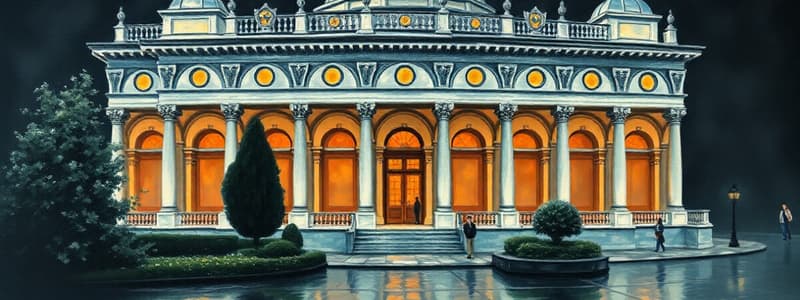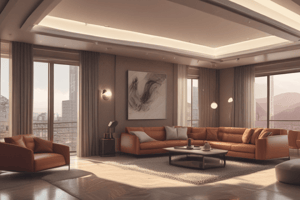Podcast
Questions and Answers
What does mass refer to in architectural design?
What does mass refer to in architectural design?
- The three-dimensional aspect of shapes within a design (correct)
- The arrangement of positive and negative spaces
- The weight of the building materials used
- The two-dimensional representation of structures
Which type of shape represents designs that imitate items found in nature?
Which type of shape represents designs that imitate items found in nature?
- Abstract shape
- Natural shape (correct)
- Non-objective shape
- Geometric shape
What is the main characteristic of negative space in architectural design?
What is the main characteristic of negative space in architectural design?
- It contains solid forms and reflects light
- It is a void that allows light to pass through (correct)
- It defines the primary mass of the building
- It is synonymous with claustrophobia
Which psychological condition is characterized by the fear of enclosure?
Which psychological condition is characterized by the fear of enclosure?
What is an example of a secondary mass in an architectural design?
What is an example of a secondary mass in an architectural design?
How is texture perceived in architectural design?
How is texture perceived in architectural design?
What do positive spaces represent in architectural design?
What do positive spaces represent in architectural design?
In the context of architectural shapes, what does non-objective shape refer to?
In the context of architectural shapes, what does non-objective shape refer to?
When designing a building, what is crucial for an architect to consider regarding space?
When designing a building, what is crucial for an architect to consider regarding space?
Which option describes the primary mass of a building?
Which option describes the primary mass of a building?
What is the primary distinction of architecture according to Roger Scruton?
What is the primary distinction of architecture according to Roger Scruton?
Which of the following elements is NOT one of the seven elements of architecture discussed?
Which of the following elements is NOT one of the seven elements of architecture discussed?
How do vertical lines in architecture influence perception?
How do vertical lines in architecture influence perception?
Which characteristic of color defines its purity relative to its original state?
Which characteristic of color defines its purity relative to its original state?
What role do materials play in architectural design?
What role do materials play in architectural design?
Which statement best describes the function of color in architecture?
Which statement best describes the function of color in architecture?
What is an essential aspect of lines in architectural design?
What is an essential aspect of lines in architectural design?
Which element is considered the most basic in all forms of visual art, including architecture?
Which element is considered the most basic in all forms of visual art, including architecture?
What impact does the selection of materials have in the practice of architecture?
What impact does the selection of materials have in the practice of architecture?
How does architecture express both utilitarian and artistic goals?
How does architecture express both utilitarian and artistic goals?
What distinguishes architecture as an art form according to Roger Scruton?
What distinguishes architecture as an art form according to Roger Scruton?
Which element of architecture is primarily responsible for creating a sense of rhythm and flow in a design?
Which element of architecture is primarily responsible for creating a sense of rhythm and flow in a design?
Why is the consideration of materials imperative in architectural design?
Why is the consideration of materials imperative in architectural design?
What characteristic of color is specifically defined as ‘the depth of hue contained’?
What characteristic of color is specifically defined as ‘the depth of hue contained’?
In architectural terms, which line type enhances the perception of height in a design?
In architectural terms, which line type enhances the perception of height in a design?
Flashcards are hidden until you start studying
Study Notes
Architecture as Art
- Architecture is considered an art as it involves visual art, design, and technical expertise.
- Roger Scruton defines architecture as the art and technique of designing and building, emphasizing its dual nature.
- Architecture serves both practical needs (functionality) and artistic goals (aesthetics).
Elements of Architecture
- Architecture consists of seven elements: materials, line, color, shape, mass, texture, and space.
Materials
- Material selection is crucial for durability, aesthetics, and structural integrity.
- Material choices reflect technological advancements over time.
Line
- A fundamental element in all art forms, lines shape, define volume, and create visual rhythm.
- Horizontal lines convey groundedness and stability, while vertical lines suggest height and upward movement.
Color
- Color is used strategically to highlight architectural features and create visual distinctions.
- Value refers to the lightness or darkness of a color.
- Hue represents the pure, primary state of a color.
- Intensity refers to the saturation or purity of a color.
Shape
- Shape is the two-dimensional representation of form.
- Different types of shapes include:
- Geometric shapes: square, triangle, circle
- Natural shapes: inspired by nature
- Abstract shapes: altered or abstracted from natural shapes
- Non-objective shapes: devoid of natural or geometric references
Mass
- Mass refers to the three-dimensional aspect of architectural shapes.
- Primary mass: the main structure or volume of a building.
- Secondary mass: smaller components like floors, walls, and ceilings.
Texture
- Texture refers to the surface appearance of materials.
- Texture is perceived both visually and tactilely.
- It significantly impacts the aesthetic appeal of a building.
Space
- Architecture involves defining and enclosing space for specific purposes.
- Claustrophobia is the fear of enclosed spaces.
- Agoraphobia is the fear of open, unenclosed spaces.
- Space is categorized as:
- Positive space: the enclosed, solid form or volume.
- Negative space: the voids or openings within the form, allowing light passage.
Conclusion
- Successful architectural design requires thoughtful consideration of all seven elements.
- Architects, engineers, and designers must collaborate to execute a project effectively.
Architecture as Art
- Architecture is considered an art form alongside visual art.
- Architects are skilled in both designing and building structures.
- Architecture serves functional and aesthetic purposes, blending utility and art.
- Architecture encompasses a range of structures, from simple shelters to complex city buildings.
Elements of Architecture
- Architecture consists of seven key elements: materials, line, color, shape, mass, texture, and space.
Materials
- Materials are crucial in architecture, reflecting the quality of the finished work and contributing to the building's longevity.
- Technological advancements impact the materials used in construction.
- Materials play a role in structural and decorative design integration.
Line
- Lines are fundamental in all art forms, including architecture.
- They define shape, form, and volume in architectural design.
- Horizontal lines evoke a low, grounded feeling.
- Vertical lines contribute to a sense of height and balance.
Color
- Color serves a strategic purpose in architecture.
- It emphasizes building character, accents forms and materials, and defines distinct sections within a design.
- Color has three key characteristics:
- Value (lightness or darkness of a hue)
- Hue (pure state of color)
- Intensity (saturation of color)
Shape
- Architectural shape refers to the two-dimensional representation of form.
- It evokes emotional responses from viewers.
- The primary form of a structure is easily perceived.
- Types of shapes include:
- Geometric shapes (square, triangle, circle)
- Natural shapes (replicating elements of nature)
- Abstract shapes (altered natural shapes)
- Non-objective shapes (not related to nature or geometry)
Mass
- Mass in architecture refers to the three-dimensional aspect of shapes.
- Two types of mass exist:
- Primary mass (the structure's form, the building's bulk)
- Secondary mass (smaller components, such as floors, walls, ceilings)
Texture
- Texture relates to the surface appearance of a structure.
- It impacts a building's initial aesthetic appeal.
- Texture is perceived visually and tactilely.
Space
- Architectural space involves enclosing undefined areas for specific purposes.
- Understanding space is essential for architectural design.
- Key concepts related to space:
- Claustrophobia (fear of enclosure)
- Agoraphobia (fear of open spaces)
- Space in architecture can be categorized as:
- Positive space (enclosed solid form, reflecting light)
- Negative space (voids in a structure, allowing light to pass through)
Studying That Suits You
Use AI to generate personalized quizzes and flashcards to suit your learning preferences.




